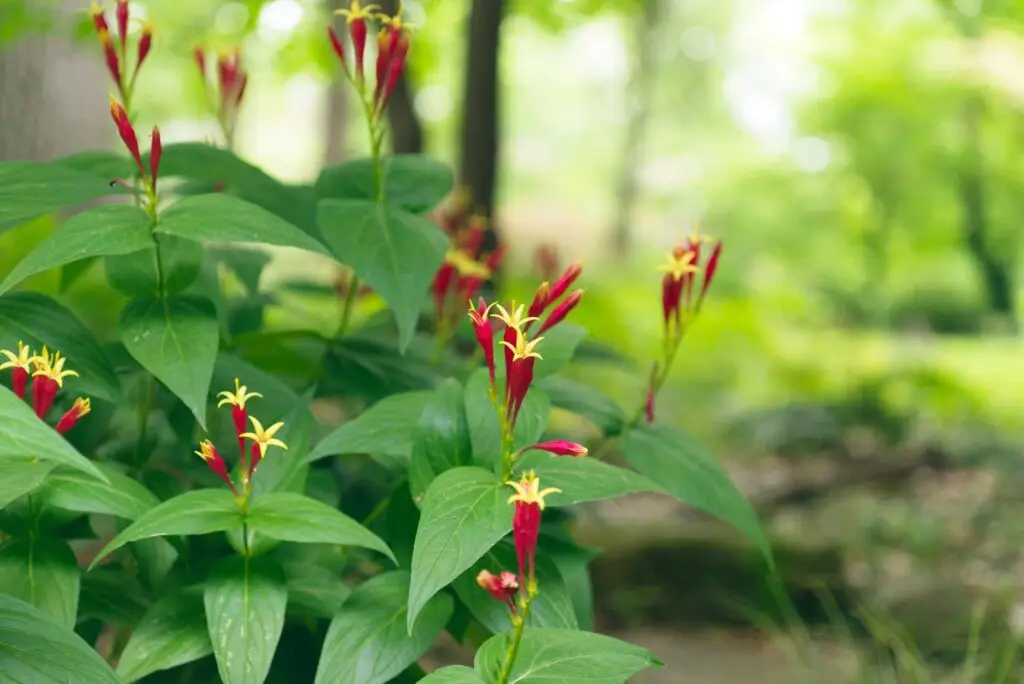Indian Pink
What an absolutely stunning native flower. Small bright-red blossoms open to reveal a yellow star center. It looks like it was perfectly cut out of construction paper. Oh, and the flowers are hummingbird favorites! Indian Pink has many common names—Pinkroot, Woodland Pinkroot—but no matter what you call it, it’s a must for shade and part-shade gardens. Scroll on for planting tips.
- Part Sun
- Short (under 3')
- Summer flowers
- Hummingbird favorite

Dig Deeper
Explore the history, types, and where to plant native Indian Pink
Table of Contents
Indian Pinks are a hummingbird favorite
Indian Pink’s number one pollinator is the Ruby-Throated Hummingbird. This long-beaked, long-tongued bird is why Indian Pink’s flower is so long and narrow. (For other hummingbird favorites, check out our Guide to Planting Hummingbird Gardens.)
These beautiful native flowers open right after spring ephemerals (like Trout Lilies) die back, in the early spring.

When does Indian Pink bloom?
Indian Pink blooms in the spring through to early summer. In the south, this is normally around March-June. In the Midwest and Mid-Atlantic, you’ll see flowers from April to early July. Indian Pink is known for its long bloom time—few native flowers stay out as long.
After the flowers bloom, the dark green leaves remain until the plant dies back in the fall. New growth will emerge the following spring.
Where is Indian Pink native?
Indian Pink is native to a wide swatch of the United States, from Maryland south to Florida, and west to Texas and Missouri. Sadly, Indian Pink is considered endangered in many of these areas.
Where can I find Indian Pink seeds or plants for my garden?
Finding a specific native flower can sometimes be challenging—most conventional nurseries do not stock lots of native plants outside of Black-Eyed Susans and Purple Coneflowers.
To help make finding Indian Pinks easier, here are four sourcing ideas to try:
Where can I find seeds and plants?
Finding native plants can be challenging (we partly blame Marie Antoinette.) To make it easier, we’ve assembled four sourcing ideas.
Native Nursery List
300+ native nurseries makes finding one a breeze
Online Native Plant Sellers
We've included 100+ online resources to help
Society Plant Sales
Every state has a native plant society; find yours
Online Communities
Local Facebook groups are a great plant source
What are good pairings for Indian Pink?
Pair Indian Pinks with other native plants that like shade or part shade and thrive in Midwest, Mid-Atlantic, and Southern gardens. Favorites include:
Indian Pink is an absolutely stunning native flower that thrives in shade or part-shade gardens. Its stunning flowers are hummingbird favorites and they stay open and beautiful for a long bloom time: from spring to early summer. Plant them with other native flowers found in Mid-Atlantic, Midwest, or Southern gardens for a fuss-free, gorgeous landscape (especially compared to lawns or non-native plants.) Check out our Guide to Hummingbird Gardens for more hummingbird landscaping inspiration. Happy planting!
Next steps and resources:
Explore native plants by region
Sources
- Nelson, Gil. Best Native Plants for Southern Gardens: A Handbook for Gardeners, Homeowners, and Professionals, (2010), 374-375.
- USDA, Woodland Pinkroot
- Harstad, Carolyn. Go Native! Gardening with Native Plants and Wildflowers in the Lower Midwest. (1999), 209-210.












